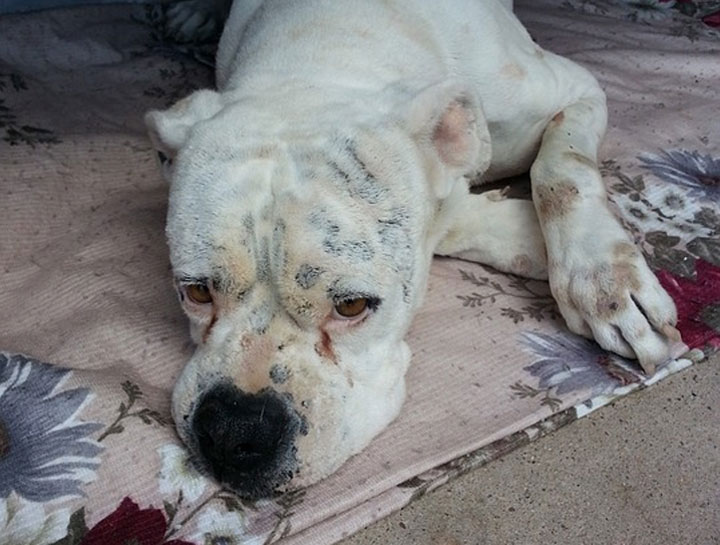Canine Influenza Vaccine

In April 2015, a new strain of canine influenza was identified by the Wisconsin Veterinary Diagnostic Laboratory. An older strain, H3N8, has a vaccine and is discussed in this article. The new strain, H3N2, is currently being researched for the development of a vaccine. It is not known whether the H3N8 vaccine will protect against the newer H3N2. We will update this article when more information about the new strain is available.—Updated May 13, 2015.
The following information on Canine Influenza Virus (CIV) is based primarily on the US Centers for Disease Control and Prevention (CDC), Key Facts About Canine Influenza (Dog Flu).
Canine Influenza
What is canine influenza (dog flu)?
Dog flu is a highly contagious respiratory disease in dogs caused by a specific Type A influenza virus. This is a disease of dogs, not of humans. The “canine influenza virus” is an influenza A H3N8 influenza virus (not a human influenza virus) that was originally an equine (horse) influenza virus. This virus has spread to dogs and can now spread between dogs. Because of the lack of previous exposure to this virus, dogs have no natural immunity to this virus. Therefore, the disease is rapidly transmitted between individual dogs.
How long has canine influenza been around?
The H3N8 equine influenza virus has been known to exist in horses for more than 40 years. In 2004, however, cases of an unknown respiratory illness in dogs (initially Greyhounds) were reported. An investigation showed that this respiratory illness was caused by the equine influenza A H3N8 virus.
Scientists believe that this virus jumped species (from horses to dogs) and has now adapted to cause illness in dogs and spread efficiently among dogs. This is now considered a new dog-specific lineage of H3N8. In September of 2005, this virus was identified by Dr. Cynda Crawford, University of Florida College of Veterinary Medicine, and Dr. Edward J. Dubovi, Cornell University College of Veterinary Medicine, as “a newly emerging pathogen in the dog population” in the United States.
What are the symptoms of this infection in dogs?
The symptoms of this illness in dogs are cough, runny nose, and fever. A small proportion of dogs, however, can develop severe disease. CIV cannot easily be distinguished from other causes of respiratory infection based on clinical signs alone. It is often mistaken for kennel cough and other respiratory infections caused by pathogens in the canine infectious respiratory disease (CIRD) complex because of shared clinical signs. CIRD complex is a relatively new term used to describe respiratory disease in dogs that may be caused by a number of co-mingled viral or bacterial pathogens. Some of the better-known pathogens are distemper virus, adenovirus type 2, parainfluenza, canine herpesvirus and Bordetella.
Canine Influenza Vaccine, H3N8
Why was the vaccine developed?
The vaccine was developed to provide more comprehensive respiratory protection for dogs, specifically to curb the spread of CIV, which has now been diagnosed in 30 states and the District of Columbia. In addition, in November 2006, the American Veterinary Medical Association (AVMA) Executive Board issued the following statement: “The AVMA believes there is urgent need for an effective canine influenza virus vaccine to improve the health and welfare of animals and reduce the financial impacts of canine influenza.”—AVMA.org
What do studies show about the vaccine’s safety and effectiveness?
Canine Influenza Vaccine, H3N8, a killed virus, has been shown to significantly decrease the signs, severity, and spread of CIV infection. The vaccine reduces the duration and severity of coughing, protects against the formation and severity of lung lesions, and significantly reduces the duration and degree of viral shedding, the period when the disease is contagious. The vaccine’s safety was confirmed in a 746-dog field study. Over 30 breeds, age 6 weeks to 10 years, participated in the testing.
Which dogs should be vaccinated against CIV?
Because CIV is a new disease, virtually every dog not previously exposed to the virus will become infected. Many dogs are candidates for the vaccine because of routine contact with other dogs who may be carrying the virus, congregating in such places as dog parks, veterinary clinics, boarding kennels, breeding kennels, dog shows, training settings, shelters, adoption centers, pet shops, neighborhood walks and other locations.
The vaccine gives veterinarians one more tool in providing their canine patients with more comprehensive respiratory protection. In addition to canine influenza, there are other causes of canine cough, such as Bordetella, or kennel cough. The risk factors are the same for both diseases—close contact and closed environments. In addition, kennel cough and CIV are difficult to differentiate in early stages because initial symptoms are similar and diagnostic confirmation of CIV can take up to 2 weeks.
What if a dog has CIV? Should it be vaccinated?
The vaccine should be given to healthy dogs, 6 weeks of age or older.
How is it administered?
The vaccine is given by subcutaneous (under the skin) injection in two doses, 2 to 4 weeks apart.
What are the possible side effects?
There were no side effects in the vaccine field safety trial, which included 746 dogs of various ages and breeds. As with any vaccine, allergic reactions may occur in a small percentage of animals.
Can the vaccine cause dogs to get CIV?
No. The vaccine cannot cause the disease because it is made with an inactivated (killed) virus.
How often should the vaccine be given?
Every year, it is recommended that the vaccine be administered annually along with the Bordetella, canine parainfluenza, and adenovirus type 2 vaccines to provide more comprehensive protection against canine infectious respiratory diseases.
Is there a particular time of year when it should be given?
The CIV vaccine can be given at any time. Unlike human flu, CIV is not seasonal, and dogs are vulnerable year-round.
Are there new strains of CIV each year, as is the case in human flu?
New strains have not been detected.
Does the CIV vaccine protect against other animal influenzas, such as swine, avian or equine?
The vaccine is specific to canine influenza.
Who developed the vaccine and why?
The vaccine was developed by research scientists at Intervet/Schering-Plough Animal Health, a leader in respiratory disease prevention and treatment, as a response to the growing incidence of outbreaks and a call for the vaccine from the AVMA.
What is a conditional license?
Conditional licenses are granted following the acceptance of data supporting product purity, product safety under normal conditions of use in field safety trials, and demonstration that the product has a reasonable expectation of efficacy. In the past, the USDA, through the Center for Veterinary Biologics (CVB), has typically issued conditional licenses to meet an emergency situation, limited market, local situation, or other special circumstances. Intervet/Schering-Plough Animal Health has conducted extensive studies and continues to work with CVB toward full licensure of the vaccine.
